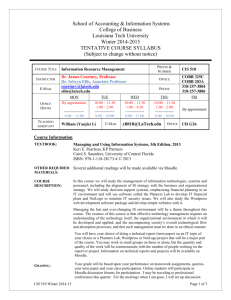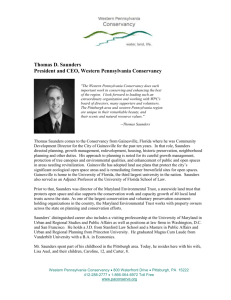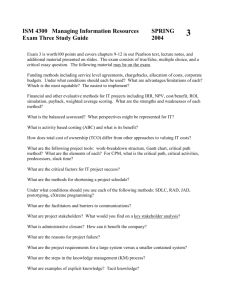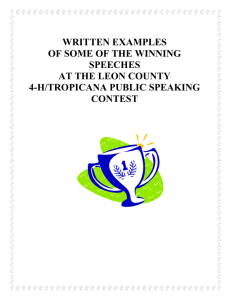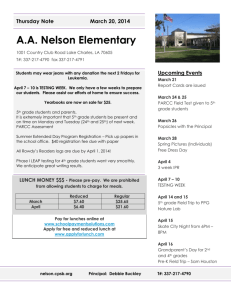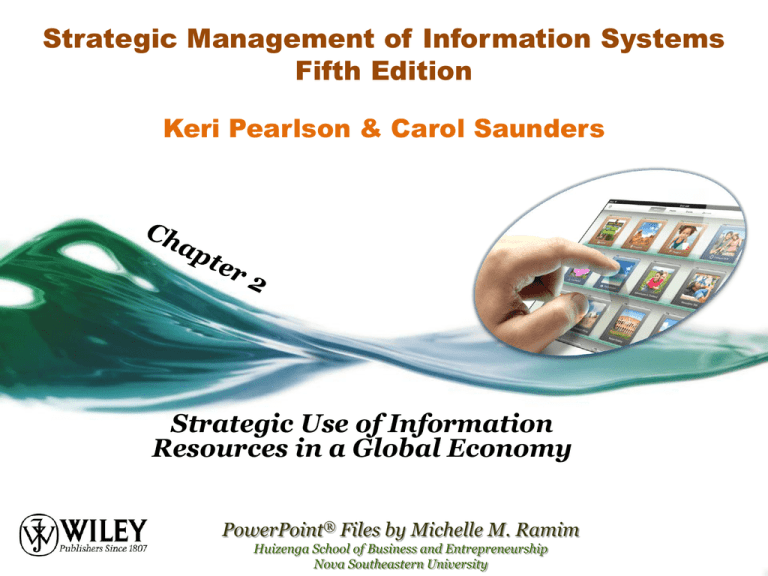
Strategic Management of Information Systems
Fifth Edition
Keri Pearlson & Carol Saunders
Strategic Use of Information
Resources in a Global Economy
PowerPoint® Files by Michelle M. Ramim
Huizenga School of Business and Entrepreneurship
Nova Southeastern University
Pearlson and Saunders – 5th Ed. – Chapter 2
Learning Objectives
•
List the identifying factors of the eras of information usage.
•
Know what makes an information resource valuable.
•
Explain how information resources are used strategically in context
of the 5-forces model.
•
Understand how information resources can be used to alter the
value chain.
•
Explain the importance of strategic alliances.
•
Know the risks of information resources.
2-2
Pearlson and Saunders – 5th Ed. – Chapter 2
Real World Example
•
Zara aligns its information system strategy with its business
strategy.
•
The system links demand to manufacturing and distribution.
•
Customers visit up to 17 times per year to check on new items that
may have arrived.
•
Limited products lead customers to immediately purchase products
they like.
•
Zara’s business strategy leads to a loyal and satisfied customer base.
2-3
Pearlson and Saunders – 5th Ed. – Chapter 2
Real World Example (Cont.)
•
•
The POS system sends daily updates to Zara’s headquarters.
Managers report to designers what sold and what customers wanted
but couldn’t find.
•
•
•
The information is used to determine inventory management.
New designs can be ordered twice a week.
The entire process is automated so that new designs and products
can be created quickly.
•
Zara uses its information resources to sustain its advantages over
competitors
2-4
Pearlson and Saunders – 5th Ed. – Chapter 2
Evolution Of Information Resources
•
IS strategy from the 1960s to the 1990s was driven by internal
organizational needs
o
Lower existing transaction costs
o
Provide support for managers by collecting and distributing
information
o
•
Redesign business processes
In the 2010 era IS strategy was driven by social IT platforms and
new capabilities
o
A new evolution of applications, processes, and strategic
opportunities
2-5
Pearlson and Saunders – 5th Ed. – Chapter 2
Figure 2.1 – Mission statements of computer companies
Primary
role of IT
Justify IT
expenditures
Era I
1960s
Era II
1970s
Era III
1980s
Era IV
1990s
Era V
2000+
Era VI
2100+
Efficiency
Effectiveness
Strategic
Strategic
Value
creation
Value
creation
Automate
existing
paper-based
processes
ROI
Solve
problems
and create
opportunities
Increasing
productivity
and better
decision
quality
Organization/
group
Increase
individual
and group
effectiveness
Competitive
position
Transform
industry/
organization
Create
collaborative
partnerships
Community
and social
business
Competitive
position
Adding value
Creating
relationships
Individual
manager/
group
Business
processes
ecosystem
Customer/
supplier
ecosystem
Data driven
User driven
Business
driven
Knowledge
driven
Customer/
employee
supplier
ecosystem
People
driven
(or
relationship
driven)
Target of
systems
Organization
Information
models
Application
specific
Pearlson and Saunders – 5th Ed. – Chapter 2
Figure 2.1 – Mission statements of computer companies (Cont.)
Era I
1960s
Era II
1970s
Era III
1980s
Era IV
1990s
Era V
2000+
Era VI
2100+
Dominate
technology
Mainframe,
“centralized
intelligence”
Minicomputer,
mostly
“centralized
intelligence”
Microcomputer,
“decentralized
intelligence”
Client
Server,
“distributed
intelligence”
Internet,
global
“ubiquitous
intelligence”
Basis of
value
Scarcity
Scarcity
Scarcity
Plentitude
Plentitude
Social
platforms,
social
networks,
mobile,
cloud
Plentitude
Underlying
economics
Economics
of
information
bundled with
economics of
things
Economics
of
information
bundled with
economics of
things
Economics
of
information
bundled with
economics of
things
Economics of
information
separated
from
economics of
things
Economics of
information
separated
from
economics of
things
Economics of
relationships
bundled with
economics of
information
Pearlson and Saunders – 5th Ed. – Chapter 2
The Strategic Role for IS – Value Creation
•
•
IS help firms address their internal and external circumstances
Enable managers to identify and use information resources
strategically
•
•
IS enable firms to gain advantage over the competition.
Firms draw on modern and innovative applications
2-8
Pearlson and Saunders – 5th Ed. – Chapter 2
Information Resources as Strategic Tools
•
•
The manager need to combine all the available firm’s resources:
Internal resources o
•
External resources o
•
Financial, production, human, and information resources,
The Internet and various global opportunities
Information resources is defined as the available data,
technology, people, and processes available to perform business
processes and tasks.
2-9
Pearlson and Saunders – 5th Ed. – Chapter 2
Information Resources
•
Information resources can be either assets or capabilities.
o
IT asset is anything, tangible or intangible, that can be used by a
firm in its processes for creating, producing and/or offering its
products, goods or services. (i.e. IT infrastructure).
o
IT capability is something that is learned or developed over time
for the firm to create, produce or offer it products.
2-10
Pearlson and Saunders – 5th Ed. – Chapter 2
IT Assets
•
IS infrastructure:
o
Includes data, technology, people, and processes.
o
The infrastructure provides the foundation for the delivery of a
firm’s products or services.
•
Information repository
o
Logically-related data that is captured, organized and
retrievable by the firm.
o
Designed to improve the firm’s efficiency.
2-11
Pearlson and Saunders – 5th Ed. – Chapter 2
IT Assets (Cont.)
•
Web 2.0 space include resources used but not owned by the firm
(eBay, Facebook, Linked-In etc.).
o
Available as a service such as Internet-based software (Software
as a Service, or SAAS)
o
Managers can manage customer information with an externally
based IT resource
o
Managers can find expertise or an entire network of individuals
ready to participate in the innovation processes of the corporate
using relatively little capital or expense. (i.e. Facebook, LinkedIn).
2-12
Pearlson and Saunders – 5th Ed. – Chapter 2
Categories of IT Capabilities
•
Technical skills - applied to designing, developing and
implementing information systems.
•
IT management skills - critical for managing the IT function and
IT projects.
•
Relationship skills - can either be externally-focused or spanning
across departments.
•
Committing and developing information resources require
substantial financial resources.
2-13
Figure 2.2 Information resources
Type of Information
Definition
Example
Pearlson and Saunders – 5th Ed. – Chapter 2
Resource
IT Asset
Anything that can be used by a firm in its processes for creating, producing and/or
offering its products (goods or services)
IS infrastructure
Base foundation of the IT portfolio
shared through the firm
Information
repository
Data that is logically related and
organized in a structured form
accessible and able for decision
making purposes.
IT Capability
Something that is learned or developed over time in order for the firm to create,
produce or offer it products in IT assets
Technical skill
Ability applied to designing,
developing and implementing
information systems
Ability to managing IT function and
IT projects
IT management skills
Relationship skills
Hardware, software, network, data
components, proprietary technology, webbased services
Critical information about customers that can
be used to gain strategic advantage. Much of
this information is increasingly available on the
web.
Proficiency in systems analysis and design;
programming skills
Being knowledgeable about business processes
and managing systems to support them;
evaluating technology options; envisioning
creative IS solutions to business problems
Ability of IS specialists to work with Spanning: having a good relationship between
parties outside the IS department.
IT and business managers
Externally-forced: have a good relationship
with an outsourcing vendor
Pearlson and Saunders – 5th Ed. – Chapter 2
Advantages of Information Resource
•
Information resource value :
o
Eras I through III – value was derived from scarcity reflected in
the cost to produce the information.
o
Era IV – value was derived from plenitude
Network effects is the value of a network node to a person or
organization, it increases when others join the network. (i.e. e-mail)
o
Rather than use production costs to guide the determination of
price, information products might be priced to reflect their value
to the buyer.
2-15
Pearlson and Saunders – 5th Ed. – Chapter 2
Advantages of Information Resource
(Cont.)
•
Information resource appropriation:
o
Determining where a resource’s value lies and how it can be improved
in a firm’s favor.
o
The attributes of information resources that impact the value make it
possible to create and sustain competitive advantage (i.e. Zara).
•
Information resource distribution across firms:
o
Early adopters may experience a competitive advantage from using an
information resource.
o
The experience gained may lead to inequities between firms.
o
Different experiences with a resource creates value, and a create
strategic advantage.
2-16
Pearlson and Saunders – 5th Ed. – Chapter 2
Advantages of Information Resource
(Cont.)
o
The value of information mushrooms under conditions of information
asymmetries.
o
Possessor of information may use it against, or sell it to, companies or
individuals who are not otherwise able to access the information.
•
Mobility of Information resource:
o
Reliance on the individual skills of IT professional
o
Risky as key individuals will leave the firm, taking their experience with
them.
o
Development of unique knowledge-sharing processes, and creation of an
organizational memory.
2-17
Pearlson and Saunders – 5th Ed. – Chapter 2
Advantages of Information Resource
(Cont.)
•
Capturing of lessons learned from all team members after the
completion of each project.
•
•
Using social technologies to record interactions and activity streams.
Information resource become obsolete:
o
•
Information resources lose value over time.
Understanding the nature of the information resources at hand is a
prerequisite to using them effectively.
•
Aligning IS strategy with business strategy enables the general
manager maximizes its profit potential.
2-18
Pearlson and Saunders – 5th Ed. – Chapter 2
Information Resources Strategy
•
Managers confront elements that influence the competitive
environment.
•
•
Slim tolerance for error.
Managers must take multiple view of the strategic landscape:
•
•
•
First view - Porter’s five competitive forces model.
Second view - Porter’s value chain.
Third view – focuses on the types of IS resources needed to gain
competitive advantage.
2-19
Pearlson and Saunders – 5th Ed. – Chapter 2
Using Information Resources to Influence
Competitive Forces
•
Porter’s five forces model show the major forces that shape the
competitive environment of the firm (figure 2.3 and 2.4).
1.
2.
3.
4.
5.
Threat of New Entrants: new firms that may enter a
companies market.
Bargaining Power of Buyers: the ability of buyers to use
their market power to decrease a firm’s competitive position
Bargaining Power of Suppliers: the ability suppliers of
the inputs of a product or service to lower a firm’s competitive
position
Threat of Substitutes: providers of equivalent or superior
alternative products
Industry Competitors: current competitors for the same
product.
2-20
Pearlson and Saunders – 5th Ed. – Chapter 2
Figure 2.3 Five competitive forces with potential strategic use of
information resources.
2-21
Pearlson and Saunders – 5th Ed. – Chapter 2
Figure 2.4 Application of five competitive forces model for Zara.
Competitive
Force
IT Influence on Competitive Force
Threat of New
Entrants
Zara’s IT supports its tightly-knit group of designers, market specialists, production managers
and production planners. New entrants are unlikely to provide IT to support relationships that
have been built over time. Further it has a rich information repository about customers that
would be hard to replicate.
Bargaining Power
of Buyers
With its constant infusion of new products, buyers are drawn to Zara stores. Zara boasts more
than 11,000 new designs a year, whereas competitors typically offer only 2,000 – 4,000.
Further, because of the low inventory that the Zara stores stock, the regulars buy products they
like when they see them because they are likely to be gone the next time they visit the store. More
recently Zara has employed laser technology to measure 10,000 women volunteers so that it can
add the measurements of ‘real’ customers into its information repositories. This means that the
new products will be more likely to fit Zara customers.
Its computer-controlled cutting machine cuts up to 1000 layers at a time. It then sends the cut
materials to suppliers who sew the pieces together. The suppliers’ work is relatively simple and
many suppliers can do the sewing. Thus, the pool of suppliers is expanded and Zara has greater
flexibility in choosing the sewing companies. Further, because Zara dyes 50% of the fabric in its
plant, it is less dependent on suppliers and can respond more quickly to mid-season changes in
customer color preferences.
Industry competitors long marketed the desire of durable, classic lines. Zara forces on meeting
customer preferences for trendy, low-cost fashion. It has the highest sales per square foot of any
of its competitors. It does so with virtually no advertising and only 10% of stock is unsold. It
keeps its inventory levels very low and offers new products at an amazing pace for the industry
(i.e., 15 days from idea to shelves). Zara has extremely efficient manufacturing and distribution
operations.
Zara offers extremely fashionable lines that are only expected to last for approximately 10 wears.
It offers trendy, appealing apparel at a hard-to-beat price.
Bargaining Power
of Suppliers
Threat of
Substitute
Products
Industrial
Competitors
2-22
Pearlson and Saunders – 5th Ed. – Chapter 2
Porter’s Value Chain Model
•
Value chain model addresses the activities that create, deliver, and
support a company’s product or service (see Figure 2.5).
•
Two broad categories:
o
Primary activities – relate directly to the value created in a
product or service.
o
Support activities – make it possible for the primary activities
to exist and remain coordinated.
2-23
Pearlson and Saunders – 5th Ed. – Chapter 2
Figure 2.5 Value chain of the firm.
2-24
Pearlson and Saunders – 5th Ed. – Chapter 2
Resources to Attain Competitive
Advantage
•
A resource is considered valuable when it enables the firm to become
more efficient or effective.
•
A resource is rare when other firms do not possess it.
o
Stakes or resources required just to be in the business.(i.e. banks and
ATMs)
o
Initially rare and valuable resources were the communities many
companies implemented using social IT.
o
These communities were a valuable resource for the firms that
sponsored them, and only a few existed.
2-25
Pearlson and Saunders – 5th Ed. – Chapter 2
Resources to Sustain Competitive
Advantage
•
Many firms who invested in systems learned that gaining a
competitive advantage does not automatically mean that you can
sustain it over the long term.
•
Need to continue to innovate and to protect against resource
imitation, substitution, or transfer.
•
Technical knowledge, especially that relates to the firm’s operation,
a gung-ho company culture, and managerial experience in the firm’s
environment is less easy to obtain and, hence, considered harder to
transfer to other firms.
2-26
Pearlson and Saunders – 5th Ed. – Chapter 2
Figure 2.8 - Information resources at Zara, by attribute
VALUE CREATION
VALUE SUSTAINABILITY
Value
Rarity
Imitation
Substitution Transfer
IT Infrastructure
M
M
H
M
H
Information Repository
H
M
M
L
M
Technical Skills
M
L
M
M
M
IT Management Skills
H
H
L
L
M
Externally-focused
H
M
L
M
L-M
Spanning
H
H
L
L
L
Information Asset
Information Capability
Relationship Skills
Note: L = low; M = medium; H = high
Adapted from Wade, M and Hulland, J. “The Resource-Based View and Information Systems Research: Review, Extension and
Suggestions for Future Research,,” MIS Quarterly, 28(1), pp. 107-142.
Pearlson and Saunders – 5th Ed. – Chapter 2
Strategic Alliances
•
An interorganizational relationship that affords one or more companies
in the relationship a strategic advantage.
•
E.g., the alliance between Zynga and Facebook helped Zynga benefit
from the revenue resulting from its gamers on Facebook community.
•
•
IS can be the platform upon which a strategic alliance functions.
E.g., The alliance between Delta and e-Travel helped Delta reduce
agency reservation fees and offered e-Travel new corporate leads.
•
Linking value chains through SCM is another way firms build an ITfacilitated strategic alliance.
2-28
Pearlson and Saunders – 5th Ed. – Chapter 2
Types of Strategic Alliances
•
Co-opetition: a new strategy whereby companies cooperate and
compete at the same time with companies in their value net.
•
Value net includes a company and its competitors and complementors,
as well as its customers and suppliers, and the interactions among all of
them.
•
Complementor is a company whose product or service is used in
conjunction with a particular product or service to make a more useful
set for the customer.
•
Co-opetition is the strategy for creating the best possible outcome for a
business by optimally combining competition and cooperation.
2-29
Pearlson and Saunders – 5th Ed. – Chapter 2
Potential Risks
•
There are many potential risks that a firm faces when attempting to use
IT to outpace their competition.
•
Awakening a sleeping giant – a large competitor with deeper
pockets may be nudged into implementing IS with even better features
(i.e FedEx and UPS).
•
Demonstrating bad timing – sometimes customers are not ready to
use the technology designed to gain strategic advantage (i.e. GRiDPAD
in 1989 and iPAD in 2010)
2-30
Pearlson and Saunders – 5th Ed. – Chapter 2
Potential Risks - (Cont.)
•
Implementing IS poorly – information systems that fail because
they are poorly implemented (i.e. Virgin America, Hershey Foods, and
Austin Energy).
•
Failing to deliver what users what – systems that don’t meet the
firm’s target market likely to fail (i.e. Netflix)
•
Web-based alternative removes advantages – consider risk of
losing any advantage obtained by an information resource that later
becomes available as a service on the web. (i.e. Clear Channel
Communications)
•
Running afoul of the law – Using IS strategically may promote
litigation (American Airlines, Google).
2-31
Pearlson and Saunders – 5th Ed. – Chapter 2
Co-Creating IT and Business Strategy
•
Information is increasingly a core component of the product or
service offered by the firm.
•
IT strategy is business strategy – they cannot be created without each
other.
•
•
Some company’s main product is information (financial services).
FedEx can not function without IT even though they are primarily a
package delivering company.
2-32
Pearlson and Saunders – 5th Ed. – Chapter 2
Chapter 2 - Key Terms
Customer relationship management (CRM) (p. 59) - a tool to
optimize the processing of customer information .
Co-opetition (p. 65) - is the strategy for creating the best possible
outcome for a business by optimally combining competition and
cooperation.
Enterprise resource planning (ERP) (p. 59) - a tool that automates
functions of the operations activities of the value chain.
Information resources (p. 47) - the available data, technology, people,
And processes available to perform business processes and tasks
2-33
Pearlson and Saunders – 5th Ed. – Chapter 2
Chapter 2 - Key Terms - (Cont.)
IT asset (p. 47) - anything, tangible or intangible, that can be used by
A Firm in its processes for creating, producing and/or offering its
products, goods or services. (i.e. IT infrastructure).
IT capability (p. 47) - something that is learned or developed over
Time for the firm to create, produce or offer it products.
Network effects (p. 48) - the value of a network node to a person or
organization, it increases when others join the network. (i.e. e-mail)
Rather than use production costs to guide the determination of price,
information products might be priced to reflect their value to the
buyer.
2-34
Pearlson and Saunders – 5th Ed. – Chapter 2
Chapter 2 - Key Terms - (Cont.)
Resource-based view (RBV) (p. 59) - competitive advantage comes
From the information and other resources of the firm.
Strategic alliance (p. 64) – an inter-organizational relationship that
affords one or more companies in the relationship a strategic
advantage.
Supply chain management (SCM) (p. 59) - an approach to how
companies source materials for operations.
Web 2.0 (p. 47) - potential resources that are available to the firm
as a service, but that are not necessarily owned by the firm.
2-35
Pearlson and Saunders – 5th Ed. – Chapter 2
Copyright 2013 John Wiley & Sons, Inc.
All rights reserved. Reproduction or translation of this work beyond that
named in Section 117 of the 1976 United States Copyright Act without
the express written consent of the copyright owner is unlawful. Request
for further information should be addressed to the Permissions
Department, John Wiley & Sons, Inc. The purchaser may make back-up
copies for his/her own use only and not for distribution or resale. The
Publisher assumes no responsibility for errors, omissions, or damages,
caused by the use of these programs or from the use of the information
contained herein
2-36

